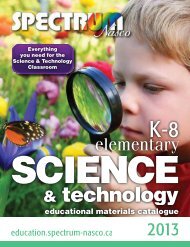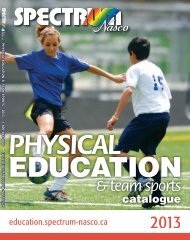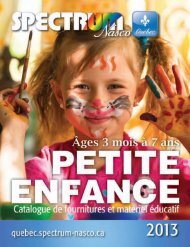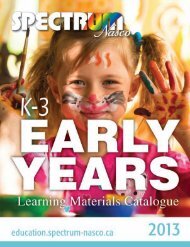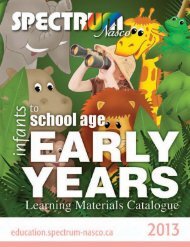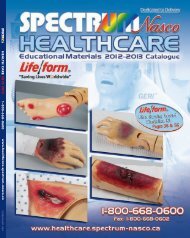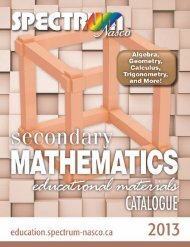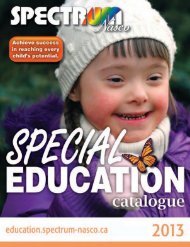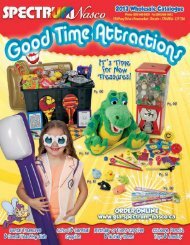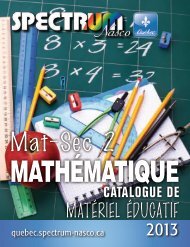educational materials - SPECTRUM Nasco Shopping Mall Divisions
educational materials - SPECTRUM Nasco Shopping Mall Divisions
educational materials - SPECTRUM Nasco Shopping Mall Divisions
You also want an ePaper? Increase the reach of your titles
YUMPU automatically turns print PDFs into web optimized ePapers that Google loves.
Quality of Water Test Kit<br />
Conduct qualitative tests on samples of water from<br />
various sources and identify pH, dissolved oxygen, odor,<br />
colour, turbidity, and coliform bacteria. Students also<br />
learn to distinguish between ground, surface, drinking,<br />
and waste water. Includes: enough <strong>materials</strong> to complete<br />
six water quality tests, teacher’s guide, and reproducible<br />
student worksheet. Grades 6—12.<br />
For 10 students.<br />
For 24 students.<br />
Sh. wt. 0.74 kgs.<br />
Sh. wt. 1.59 kgs.<br />
SB33056M — $102.05 SB33057M — $144.60<br />
Water<br />
Innovating Science<br />
GREEN CHEMISTRY<br />
Earth Science<br />
Pond Test Kit<br />
Includes: 10 tests each for ammonia, nitrate, nitrite, and pH<br />
levels. Sh. wt. 1.16 kgs.<br />
C18889M — $17.80<br />
Electrochemical Remediation<br />
of Wastewater<br />
Water pollution is one of the largest threats facing<br />
the global population. Water is a finite resource. Once<br />
polluted, it cannot be set aside in the hopes that the<br />
environment will “make” new, clean water. Recently, a<br />
great deal of attention has been given to less traditional<br />
alternatives to the typical process of coagulation/flocculation.<br />
One such approach receiving a good<br />
deal of attention is a process called electrocoagulation.<br />
Electrocoagulation is a coagulation process carried out<br />
by an electrical charge.<br />
SB45474M — $74.70<br />
Detergents and the Environment<br />
Understand the consequences of cultural nutrient<br />
overloading on the aquatic environment. Demonstrate<br />
and monitor the effects of two detergent builders on<br />
natural water samples. Visually quantify the differences<br />
between phosphate and non-phosphate detergent<br />
builders on aquatic organisms.<br />
1323M — $43.95<br />
The Production of Biodiesel<br />
In this activity, students will be performing a twophase<br />
process to produce small batches of crude<br />
biodiesel. The crude biodiesel produced is of sufficient<br />
quality for use in the demonstration of the burning<br />
qualities of both biodiesel and vegetable oil. Included<br />
is an optional small-scale exercise where the students<br />
will use a washing procedure for the crude biodiesel.<br />
1319M — $53.95<br />
Water Treatment and Filtration<br />
Students will develop a knowledge of the processes<br />
performed at a water treatment plant and understand<br />
the reasons for each process. They will perform, on a<br />
small-scale, several of the procedures that occur in a<br />
water treatment plant on “polluted” water. They will<br />
examine the changes in the water after each treatment<br />
step is performed.<br />
SB45473M — $64.00<br />
Cleaning Up Oil Spills with Oil-Hungry<br />
Bacteria Lab<br />
Model various oil spill scenarios and monitor the effectiveness of<br />
the provided freeze-dried, oil-degrading microbe mixture in remediating<br />
the waste. Students set up a simulated oil spill in water and treat it<br />
with the microbial product to observe the physical changes and degradation<br />
of the oil film over time. Additionally, students simulate three spill scenarios on<br />
beach sand, gravel, and cobbles to observe the difference in degradation rates.<br />
The class will also explore bioremediation methods for other waste chemicals<br />
and compare their effectiveness to traditional clean-up methods. Materials for<br />
40 students. Grades 7-10. Sh. wt. 7 lbs.<br />
SB48359M— $95.15<br />
Refill Kit. Sh. wt. 1.25 lbs.<br />
SB48360M — $33.30<br />
Bioremediation by Oil Eating Bacteria<br />
The naturally occurring process of biodegradation can be<br />
enhanced by bioremediation to minimize the catastrophic<br />
effects of oil spills. Students grow a mixture of oil eating<br />
bacteria and demonstrate how the enzymes produced by<br />
these microbes digest hydrocarbon molecules, causing<br />
degradation. Includes: instructions, background information,<br />
study questions, oil-eating bacteria pellets, growth<br />
medium, and pipets. Grades 6—12. Sh. wt. 0.63 kgs.<br />
SB39284M — $138.00<br />
www.education.spectrum-nasco.ca<br />
Using Chemical Reactions to Reduce Waste<br />
Students learn that wastes from many industrial processes<br />
contain toxic or valuable substances that can sometimes<br />
be reclaimed then recycled or disposed of safely. Working<br />
in groups, students reclaim copper from a liquid “waste”<br />
containing dissolved copper chloride. They measure the<br />
effectiveness of three different metal replacement reactions<br />
at removing the copper from the “waste.” They then<br />
compare the effectiveness, cost, and safety information for<br />
each replacement reaction and decide which metal would<br />
be the best to use for removing the copper from the “waste.”<br />
Designed for six groups of 4 or 5. Grades 6—12. Sh. wt. 3 lbs.<br />
SB44073M — $94.65<br />
Additional Kit. Sh. wt. 1.06 lbs.<br />
SB44074M — $16.45<br />
113



